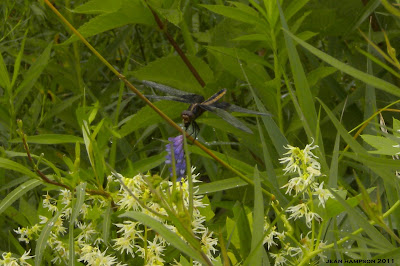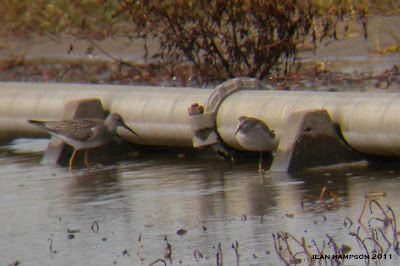2011 is quickly coming to an end and year lists will soon reset to zero. Though Jean and I had some misses this year, 2011 turned out to be better than I anticipated. Currently the list stands at 216 species, 8 more than last year's personal best. No where near Barb Charlton's amazing run of 322 species, but beating a personal best is always sweet. Ticking 300+ species in one year for the provincial list will have to wait until time is more readily available (retirement).
Speaking of time. I never did get the chance to post the late summer and fall ticks. Not sure what happened. There were some really good birds during these weeks. A few required some work (hiking along a trail and climbing over fallen Willows for example) and some simply fell into my lap. Whatever the case, there was never an outing that I did not enjoy.
Looking for Orchard Oriole:
July 30
Over 30 species were observed while walking along the Dofasco Trail 2000 in Stoney Creek and only one of them was added to the year list. We were looking for Orchard Oriole and like last year, there was no sign of North America's smallest oriole. As a consolation, we spotted our first of the year Field Sparrow (#184). I should change my plans for next year. Jean and I will go looking for Field Sparrow and we'll end up finding Orchard Oriole.
August 1
It's been over two years since we last observed Orchard Oriole, even longer when specifically looking over my Glenridge Naturalization Site list. In May of 2007, Jean and I watched a female Orchard Oriole weave a nest while we were birding in the former quarry/municipal dump.
We walked 2.0 km of trails and ticked 25 species.
Still no Orchard Oriole. It's another year without this bird.
August 7: OFO Rock Point Trip
Thankfully, it was an overcast day. Birding at Rock Point and the surrounding area can be uncomfortable when the sun is blazing down on Haldimand County. I was looking for shorebirds and Rock Point Provincial Park in August is worth your time and energy.
The group spent an hour exploring the shoreline of the park. Jean and I added Semipalmated Plover, Sanderling, Semipalmated Sandpiper, Least Sandpiper, White-rumped Sandpiper, and Lesser Yellowlegs to the year list. Oddly, we found no Ruddy Turnstone. We've observed this species the last 4 years when birding at Rock Point. Can I really afford to miss this one in 2011?
At the evaporation ponds north of the park, 4 more ticks for the year list. Additional shorebirds added included, Solitary Sandpiper, Pectoral Sandpiper, and Greater Yellowlegs. In the waterfowl category, we observed a Green-winged Teal. The list stood at 194 species and we had yet to scan the sod farms for Black-bellied Plover.
John Black and Dan Salisbury (trip leaders) scouted the sod farms the previous day and found nothing. The day of the trip produced the same result. No Black-bellied Plover. Two shorebirds missed.
Cottage Bound
In mid-August, Jean and I headed up to the cottage my brother-in-law was renting for a week of relaxing on the sands of Inverhuron.
Repeating last year's route, we stopped off at the Luther Marsh in Dufferin County before continuing on to the cottage. In 2010, we purposely stopped at the marsh with the intent to tick a lifer bird. Thanks to the appearance of a lost Scissor-tailed Flycatcher, the Luther Marsh is now a planned stop when travelling to the Kincardine and Inverhuron area.
One day was set aside to act as birding guides for friends and family (as per the kids' request). We hiked the Tower Trail in MacGregor Point Provincial Park and found a good selection for the aspiring birders (we can only hope).
What really caught our undivided attention (at least Jean and I) was the announcement of a future bird blind. As stated in the sign, we should be able to access a bird blind when visiting next year. Do I sense a Pileated Woodpecker tick?
There were no avian additions to the year list in Bruce County, but Jean did some good spotting on the Tower Trail when she found this Spring Peeper. The kids enjoyed seeing this amphibian up close and snapped a few pics themselves.
Heading home last year, we drove through the town of Mitchell and unknowingly let two lifers (possibly three) slip through our fingers. Godwits! This year, I was not about to let that happen again. So, we stopped in the small town that is the "Home of Howie Morenz" to see exactly what all the fuss is about these former sewage lagoons.
Tell a non-birder you visited a sewage lagoon while on vacation and they look at you as if it was a total waste of a good vacation. Tell a birder and they'll ask you, "what you get?".
Waterfowl, wading birds, shorebirds and gulls abound.
Including 3 Black-bellied Plover (#195), a shorebird species missed at the sod farms in Dunnville. The lagoons were a worthwhile stop on a late summer afternoon.
In late August, we stopped by another former sewage lagoon, The Wetland Ridge Trail in Niagara-on-the-Lake, after a family picnic. We were there to look or should I say hear our annual Common Nighthawk tick. I could still see my hand in front of my face, but there was not enough light to see any of the 8 Common Nighthawks that were hidden in the trees.
September 5
No luck finding Ruddy Turnstone when revisiting Rock Point for my father-in-law's birthday in early September. There were no tricks involved. He really wanted to go there!
September 17 & 18: OFO Annual Convention
The annual OFO convention is held every other year at Point Pelee. Jean and I have still to visit the national park during the height of spring migration and until then, we'll continue with the biannual autumn sojourn. Being a birder that cannot take a week's vacation in May really does smart.
On Saturday morning, we hiked along the Tip. There was a moment of excitement when I heard someone call out Olive-sided Flycatcher. Jean and I have not seen this bird for over three years. It turned out to be a pewee.
After birding the Tip, the North-West Beach, and Sanctuary Pond, Northern Parula was the only FOY tick.
We travelled along Old #3 early Sunday morning for a day of birding in Chatham-Kent with trip leader Blake Mann. At Rondeau Provincial Park, every effort was made to find a warbler not seen this year. You had to be in the right spot at the right time. Prairie Warbler (a lifer tick) and Blackburnian Warbler were missed.
In Blenheim, we had a great afternoon of birding at the sewage lagoons.
Added to the 2011 Ontario list, Red-necked Phalarope.
....walking toward the sprinkler cell (our backs to the lagoon containing the phalarope) Blake turned around to see a large flock of Bonaparte's and quickly called out Little Gull. The moment Jean and I turned around, we were both on the Little Gull at the same time. #199 for the year.
A good selection of shorebirds in the shallows of the sprinkler cell, including a somewhat shy Stilt Sandpiper.
I always enjoy the convention and we're looking forward to next year's at Presqu'ile Provincial Park. An area of Ontario we have never birded.
October 8: OFO Hamilton Trip
Our last FOY ticks before the "Thanksgiving Purple Gallinule" occurred on the OFO trip in the Hamilton area.
The Windermere Basin has undergone a drastic change since the last visit.
The mounds of earth made observing shorebirds quite difficult. Luck was on our side and we ticked a FOY Dunlin. Needless to say, waterfowl were in short supply.
We hiked in the Dundas Marsh in search of a fall visitor. When we last observed this species (lifer tick), the Emberizid was known as Nelson's Sharp-tailed Sparrow. This time, the FOY tick is listed as a Nelson's Sparrow.
We continued our walk as far as we could along the creek and reached the mud flats of Cootes Paradise. Here we were treated to our lifer Hudsonian Godwit (#309 and #203 for 2011). Even after noting the size of the shorebird in our field guide, it was still surprising to see that is smaller than the gulls it was keeping company with.
Overall, it was an exciting year. 2011 is practically over and done with. Our total for the year stands at 216 species, barring any last minute additions today. Although perhaps not a huge number with compared to some others out there, we achieved this total while working full time and staying mainly within Southern Ontario. Let the 2012 madness begin!
Happy New Year and Good Birding!
Recent Bird and Plant Sightings and Other Things
10 hours ago


























































